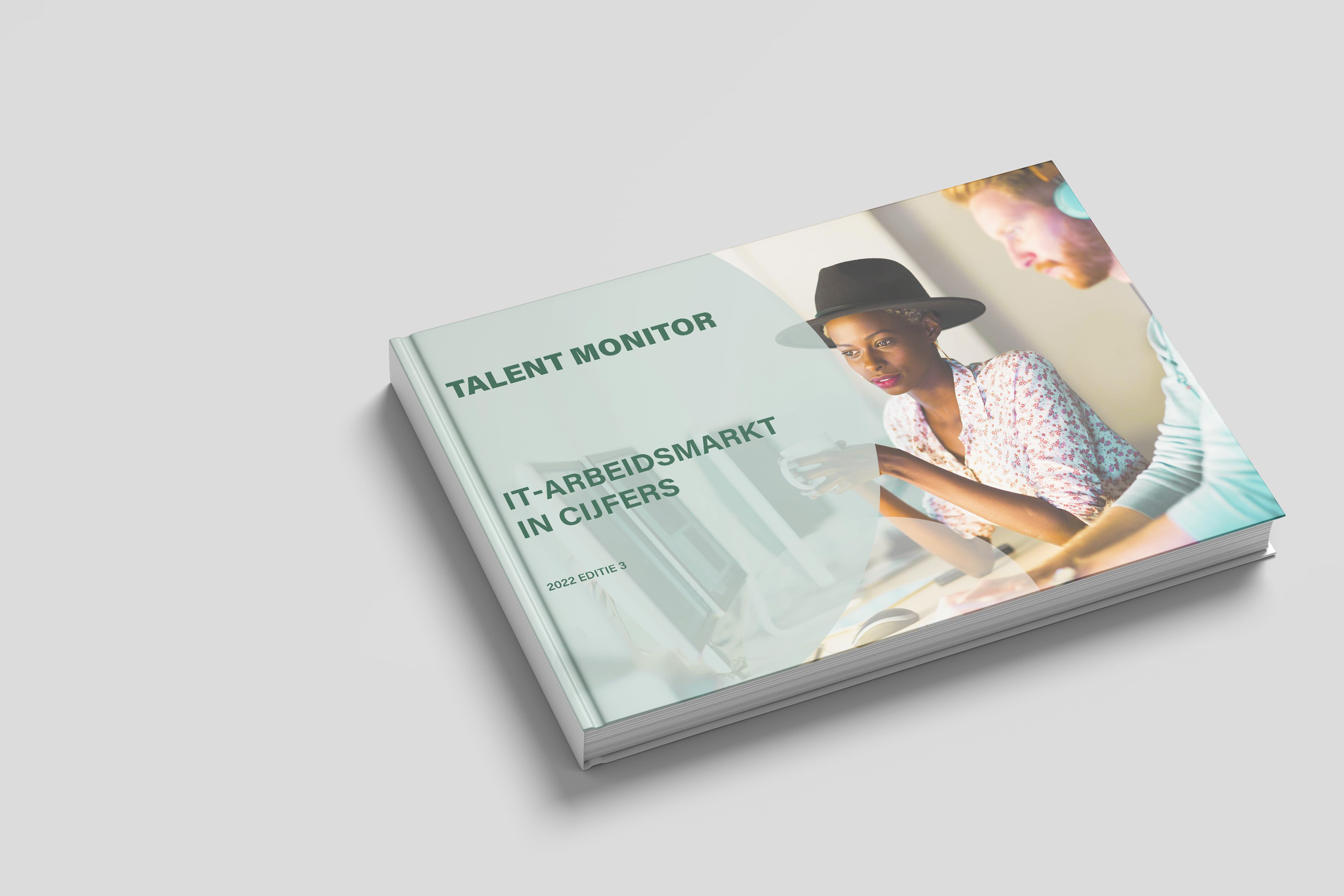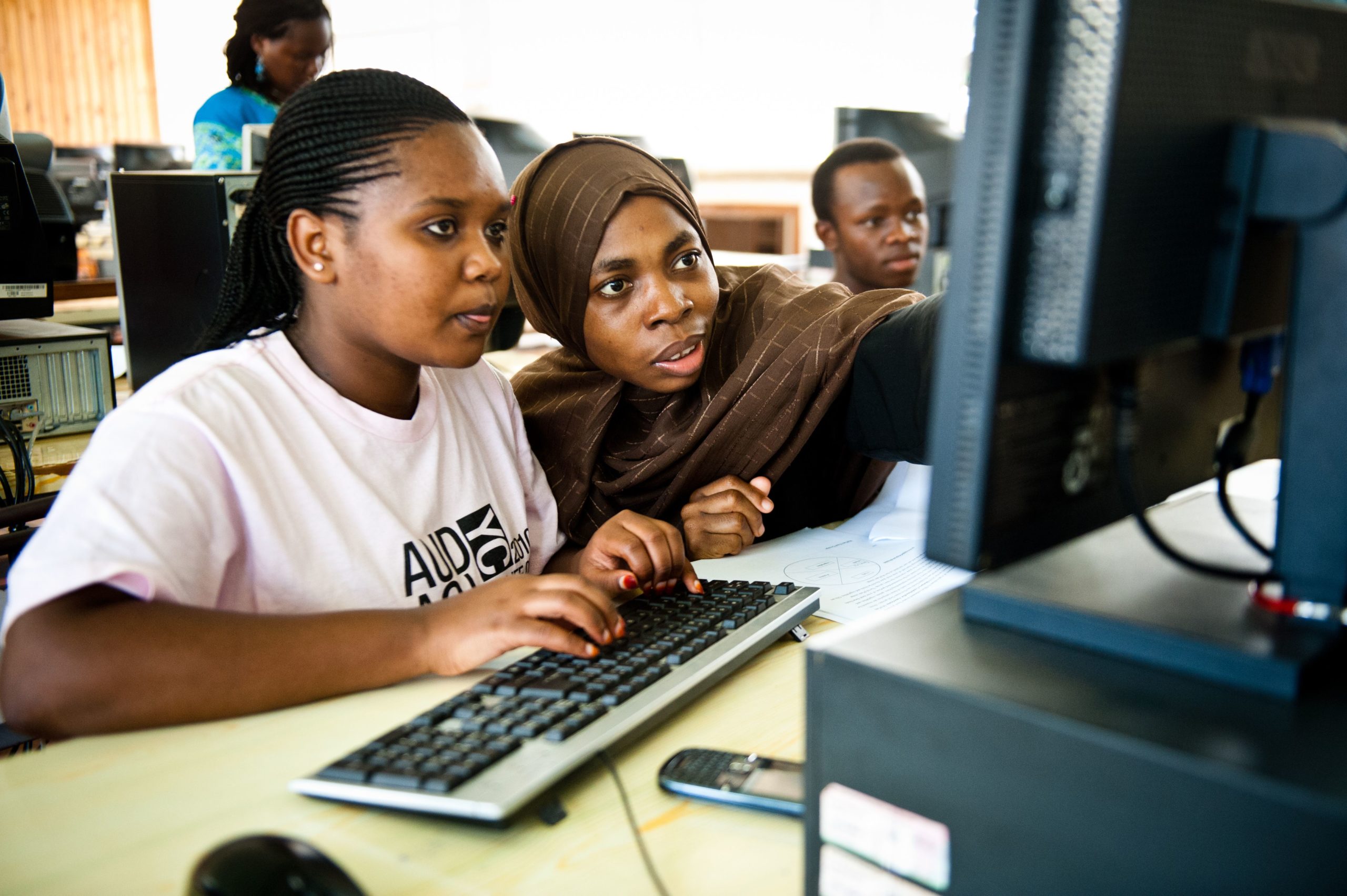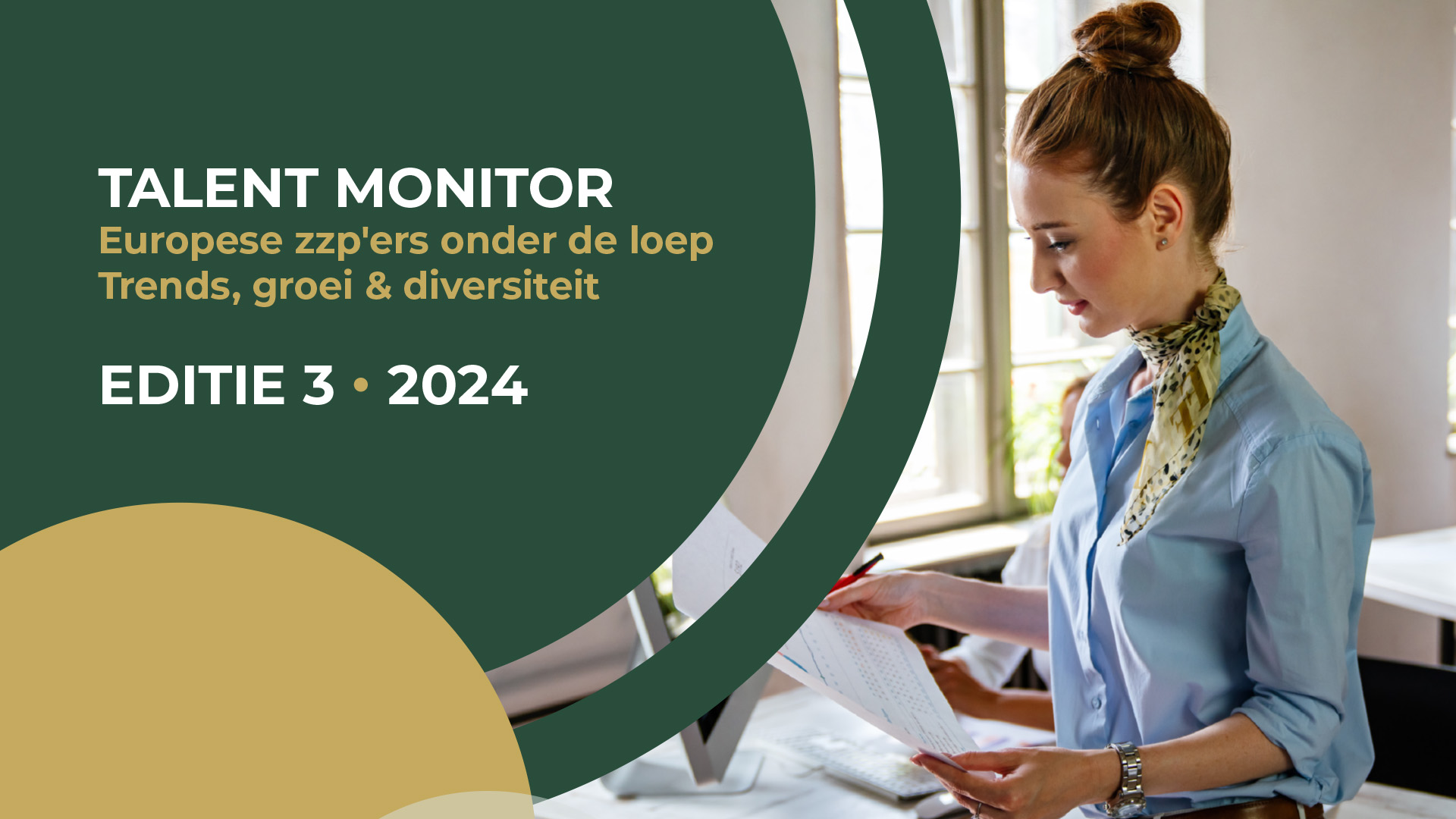Rate development professionals 2025
Rate development professionals 2025
The Talent Monitor provides an in-depth analysis of trends and developments in the market for independent professionals and secondees. This report examines the impact of legislation, labor market movements and the scarcity of highly skilled self-employed professionals, with insights on rates, supply and demand, and expectations for 2025.
Hourly rates for self-employed and seconded workers continue to lag behind collective bargaining wages in 2024
The hourly rates of flexible workers, self-employed workers and professionals employed by secondment agencies, rose an average of 3.6 percent in 2024 compared to 2023. This increase lags behind average collective bargaining wage increases and rate increases for (practically skilled) self-employed workers. A limited rate increase is expected for 2025, between 1 and 1.5 percent. This is according to the latest Talent Monitor from labor market data specialist Intelligence Group and HR-tech service provider HeadFirst Group.
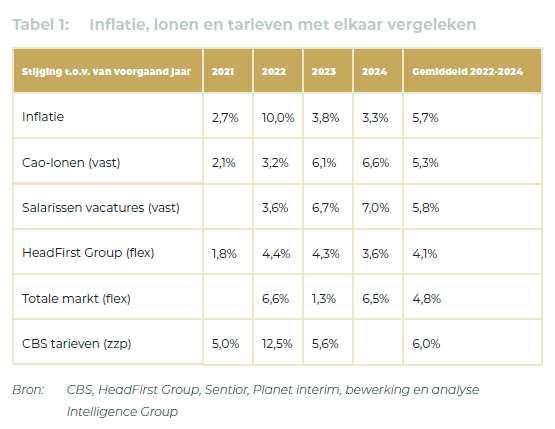
What to expect:
- Detailed analyses of labor market trends and rate changes.
- In-depth insights into the impact of legislation (such as the DBA Act) on the zzp market.
- Forecasts for the labor market in 2025, including forecasts for rates and the employment situation.
Summary of key findings:
- The number of self-employed workers rises slightly to nearly 1.1 million, with labor market activity increasing.
- Fees for independent professionals lag behind inflation and wage increases, with a projected increase between 0.5% and 1% in 2025.
- The demand for self-employed workers remains high, but the flexibility and choices of workers, especially self-employed workers, are determining trends.
Partner

Download Talent Monitor
By downloading the Talent Monitor, you agree that your data will be shared with co-initiator Intelligence Group.
Other reports...
Talent Monitor: The convergence of fixed and flex
We compile quarterly - based on recruitment data from...
Talent Monitor: Fixed is getting more mobile and flex is getting more sustainable
We compile quarterly - based on recruitment data from...
Talent Monitor: Rate development professionals 2023
We compile quarterly - based on recruitment data from...
Talent Monitor | ICT labor market in figures 2024 - 2025
ICT labor market in figures 2024 - 2025
Since the 1990s, ICT professionals have been at the forefront of the labor market. From introducing work-life balance to pioneering online platforms such as LinkedIn, ICT professionals have always been at the forefront of labor market innovations. Now the sector is in a critical transition phase that could affect not only the ICT market itself, but the broader labor market. Find out what this means for employers, employees and (self-employed) ICT professionals.
Cabinet goal unachievable: no 1 million ICT workers by 2030
While the government is aiming for one million ICT workers in the Netherlands by 2030, new research by labor market data specialist Intelligence Group and HR-tech service provider HeadFirst Group suggests that this goal is far out of reach. Even in a scenario of explosive growth, the Netherlands would have a maximum of 862,000 ICT workers by 2030. In more likely scenarios, the number is much lower still: between 628,000 and 783,000. Marion van Happen, CEO at HeadFirst Group nuances, "We don't have to meet the set target because AI can take over certain roles of ICT workers."
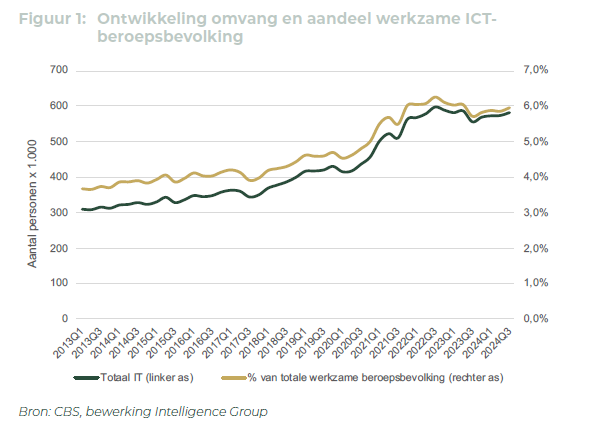
What will you learn from this report?
In this detailed Talent Monitor, we chart current trends in the ICT labor market:
- How the long-term growth in the number of ICT workers is slowing down and the role of AI in this change.
- The high employment rate of ICT workers, both salaried and self-employed.
- Declining Demand: The declining demand for ICT workers and how this affects recruitment strategies.
- What employers are doing differently now to attract ICT workers, including the impact of the DBA law.
- How specific ICT skills are key to both the current and future job market.
- What rising rates mean for freelancers in the industry.
- As AI and globalization change norms, what can we expect from industry dynamics?
Partner

Download Talent Monitor
By downloading the Talent Monitor, you agree that your data will be shared with co-initiator Intelligence Group.
Other reports...
Talent Monitor: The convergence of fixed and flex
We compile quarterly - based on recruitment data from...
Talent Monitor: Fixed is getting more mobile and flex is getting more sustainable
We compile quarterly - based on recruitment data from...
Talent Monitor: Rate development professionals 2023
We compile quarterly - based on recruitment data from...
HeadFirst Group achieves Gold EcoVadis rating
As a leading HR-tech service provider, we see it as our responsibility to make a positive impact. We strive for fair labor markets and sustainable employability, and take our role in the path to a sustainable world seriously. After achieving a Silver EcoVadis rating in 2022, this year we are proud to announce that we have taken the next step: a Gold EcoVadis rating.
Award for our comprehensive ESG policy.
EcoVadis rates companies worldwide on their sustainability efforts, evaluating over 100,000 organizations on criteria within environment, labor conditions, ethics and sustainable sourcing. With a presence in more than 160 countries, EcoVadis is a highly valuable benchmarking platform, and our gold status places HeadFirst Group in the top 2% of companies worldwide on sustainability. With a whopping 90 points on the Environment theme, we are among the leaders in Carbon Management, meaning we have a strong system for managing our carbon emissions and ambitious plans to further reduce our emissions, supported by solid action plans and transparent reporting.
This recognition is the result of our commitment to various ESG (Environmental, Social, and Governance) themes. We have developed a comprehensive policy that includes concrete actions and clear objectives to contribute to a more sustainable future.
The next step: B Corp certification
Our gold EcoVadis status is a fantastic milestone, but we continue to look ahead. To further increase our impact, we have now also applied for B Corp certification. B Corp is aimed at companies committed to the highest standards of social and environmental performance, transparency and accountability. This fits perfectly with our ambition to have a positive impact on all our stakeholders and the world around us.
Together towards a sustainable future
With our ESG policy, our new EcoVadis gold status and move toward B Corp certification, we remain committed to achieving the best results for both our clients and society. HeadFirst Group stands for sustainability and responsible growth, and we continue to actively contribute to a world where fair opportunities and sustainable practices are central.


Emancipation drives number of female self-employed in Europe
After steady growth over the past 15 years, one in three self-employed people in Europe are now women. This growth goes hand in hand with increasing gender equality in Europe. In the Netherlands, 37.8 percent of self-employed people are women, which puts us in 11th place in Europe. Research for the latest Talent Monitor, conducted by labor market specialist Intelligence Group and HR-tech service provider HeadFirst Group, shows that the further emancipation has progressed in a country, the more women choose self-employment.
Rise of female self-employed workers
An extensive analysis of data since 2010, shows a very strong relationship between emancipation and the proportion of female self-employed workers in Europe. By linking the data to the World Economic Forum's Gender Gap Index (GGI), which measures gender inequality, a clear correlation was found. In countries with smaller gender gaps, the percentage of female self-employed workers is significantly higher, it can be argued. In other words, increasing gender equality encourages entrepreneurship among women. This is a very good trend and at the same time emphasizes the need to continue promoting equal opportunities as an engine for economic and social growth," said Marion van Happen, CEO of HeadFirst Group.
By 2024, 36 percent of self-employed workers in the European Union (EU-27) will be women, up from 34 percent in 2010. As of this year, Luxembourg is the first European country where more than half of the self-employed are women (50.7 percent). Latvia follows with almost an equal share (49.8 percent), while countries such as Ireland (26.8 percent) and Romania (26.9 percent) lag far behind. In the Netherlands, the percentage is 37.8, slightly higher than in Belgium (36.6 percent).
Fewer hours, more women
The study also shows that in countries where self-employed workers work fewer hours per week on average, the proportion of female self-employed workers tends to be higher. On the contrary, in countries where the difference in hours worked between men and women as self-employed workers is small, we see relatively fewer female self-employed workers. "Being self-employed offers women an attractive form of work because it allows them to combine care responsibilities with flexibility and a better work-life balance. The possibility to work fewer hours or achieve other ambitions as a self-employed worker contributes to their autonomy and strengthens women's emancipation," said Geert-Jan Waasdorp, director and founder of Intelligence Group.
In Europe, men work an average of 40.9 hours per week as self-employed, while women work an average of 34.5 hours. Greek self-employed workers work the most hours (43.4 hours), followed by Spanish self-employed workers (41.7 hours). Luxembourg self-employed workers make the fewest hours (30.8 hours), followed by Estonian self-employed workers (31.9 hours). In the Netherlands, the average is 33.6 hours, well below the European average.
The full report is available for download at headfirst.group.
Donate your old IT equipment for a good cause!
We are always looking for ways to take our social responsibility and contribute to a better world. That's why we are pleased to announce a new initiative in partnership with Close the Gap, in honor of International E-waste Day on Oct. 14. Help out by donating used laptops, desktops, tablets, smartphones and printers. By doing so, you reduce the e-waste mountain and contribute to education and employment in developing countries.
Why participate.
Close the Gap aims to reduce the digital divide by giving used IT equipment a second life in developing countries.
- Help make technology accessible to all and see immediately the difference your donation makes.
- Reduce e-waste and contribute to a more sustainable world.
- Suppliers who donate receive an honorable mention on our website, highlighting your commitment to sustainability and social responsibility.
How does it work?
- Collect old appliances that still work and register them using this form.
- Bring the devices to our headquarters in Hoofddorp or if there is really no other way, let us know when we can pick them up.
- We make sure the devices get to Close the Gap. They manage the entire data erasure process and guarantee that it is done professionally. If you still have doubts, you can delete the data yourself in a few simple steps.
We hope you will take this opportunity to join us in making a difference. As a token of our appreciation, you will receive a small gift from us when you donate. If you have any questions or would like more information, please do not hesitate to contact us at skip.saegaert@headfirst.nl.
Talent Monitor | European self-employed under the microscope: Trends, growth & diversity
European self-employed under the microscope: Trends, growth & diversity
The European labor market is in flux. With nearly 20 million self-employed spread across several countries, there are big differences in how this group develops. The Netherlands leads the way with unique trends in flexible work, but how do we compare to the rest of Europe?
The Talent Monitor offers an in-depth analysis of the European self-employed market, sharing insights you shouldn't miss.
Increasing number of self-employed people under 30 in the Netherlands, Belgian numbers actually decreasing
Over the past five years, the number of self-employed people under 30 in the Netherlands has increased significantly, accounting for 12.7 percent of the total number of self-employed people in our country. This places the Netherlands among the top European countries, along with countries such as Malta, Slovakia and Lithuania. In contrast to the Netherlands, Belgium - at almost 4 percent - has actually seen a decline in the number of young self-employed people. This is shown in the most recent Talent Monitor, a joint study by labor market data specialist Intelligence Group and HR-tech service provider HeadFirst Group.
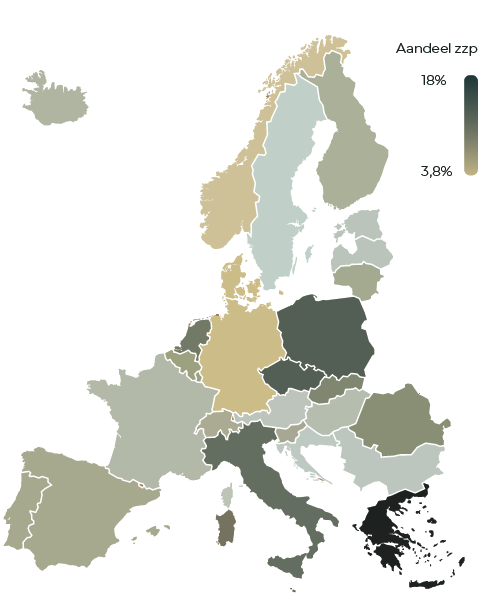
What can you expect in this report?
- A unique comparison between the Dutch labor market and the rest of Europe.
- Find out why older and highly educated self-employed people dominate, and why younger people are less likely to become self-employed.
- Analysis of the growing role of women in the self-employed market and its link to emancipation.
Who should read this report?
- Legislators: To place the Dutch labor market in a broader European perspective.
- Clients with international ambitions: To develop an effective European recruitment strategy.
- Zzp'ers: To understand how unique the Dutch zzp is compared to other European countries.
Partner

Download Talent Monitor
By downloading the Talent Monitor, you agree that your data will be shared with co-initiator Intelligence Group.
Other reports...
Talent Monitor: The convergence of fixed and flex
We compile quarterly - based on recruitment data from...
Talent Monitor: Fixed is getting more mobile and flex is getting more sustainable
We compile quarterly - based on recruitment data from...
Talent Monitor: Rate development professionals 2023
We compile quarterly - based on recruitment data from...
Success of female self-employed surpasses men in labor market
The latest Talent Monitor, a joint study by labor market data specialist Intelligence Group and HR-tech service provider HeadFirst Group, shows that female professionals - self-employed or employed by suppliers - are 68 percent more successful in obtaining assignments than their male counterparts. Moreover, the data analysis shows that female self-employed professionals no longer have a gender pay gap in hourly rates, whereas this was still the case before the corona pandemic.
Missed opportunity for recruiters
Despite the success of female professionals in winning assignments, they are less actively approached by recruiters than men. The analysis shows that, on average, men are approached one-third more often than women. Among independent professionals, this is just under 19 times per year among men versus nearly 15 times per year among women. Among employed workers, this happens more than 10 times a year versus nearly seven times a year.
Geert-Jan Waasdorp, director and founder of Intelligence Group, says: "Men are more likely to work full-time and are therefore attractive to recruiters. This could be financially driven, as more hours also means more turnover for a recruitment agency. In addition, a possible factor is that LinkedIn, one of the main sourcing channels, is slightly over-represented by men."
Marion van Happen, CEO of HeadFirst Group, adds: "This surprising insight highlights the importance of measuring effective recruitment efforts. Gut feeling no longer represents market dynamics. Organizations that get their numbers, both internal and external, right are demonstrably more successful in placement, growth and profitability."
Gender equality in hourly rates
Where exactly there is no difference between male and female professionals is in the hourly rate. The rates have converged significantly over the past six years. Up to and including the first quarter of 2020, this difference was 10.3 percent, but after this corona period, the difference has become minimal and moreover not explanatory on the basis of gender. This is in contrast to other segments of the market or contract types where this is still the case. Of course, factors such as work experience, field and education level still play a role in explaining differences in rates.
"This groundbreaking result from our data analysis points to a promising development: there is no longer a gender pay gap between male and female professionals. This represents a crucial step toward a just and equal labor market for all. It is an inspiring goal to which we, together with our rapidly growing ecosystem, are striving," Van Happen concludes.
The Talent Monitor provides valuable insights into labor market movements and gender dynamics in the job market. The full report is available for free download at headfirst.group.
Talent Monitor | Labor market movements: the men versus the women
Labor market movements: the men versus the women
It is no surprise that there is (unconscious) bias among recruiters, clients or employers when it comes to attracting male and female workers. At least a few times a year, newspapers headline the huge salary gap between the two genders. However, as far as professionals are concerned, the difference in hourly rates has become very small and, more importantly, no longer statistically explainable by gender. Other factors, such as work experience and education level, now explain the difference. These and several surprising insights are presented in this Talent Monitor.
Success of female self-employed surpasses men in labor market
The latest Talent Monitor, a joint study by labor market data specialist Intelligence Group and HR-tech service provider HeadFirst Group, shows that female professionals - self-employed or employed by suppliers - are 68 percent more successful in obtaining assignments than their male counterparts. Moreover, the data analysis shows that female self-employed professionals no longer have a gender pay gap in hourly rates, whereas this was still the case before the corona pandemic.
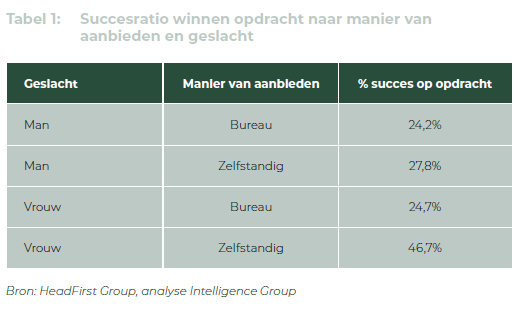
Key findings
- Female professionals are not paid significantly less or more per hour for the same work compared to male professionals. What is striking is that women, not significantly but structurally, get or accept a lower rate than men for the same work. The average difference is 1 to 2 euros per hour.
- Factors such as work experience, area of expertise and level of education do determine different hourly rates, as does the extent to which being an independent professional is the main daily occupation. In other words, independent professionals who combine their work with other activities such as volunteering, being a househusband or housewife tend to receive lower hourly rates.
- Women are more successful than men in obtaining assignments. Female independent professionals without an agency are 68% more successful in scoring an assignment than male independent professionals without an agency.
- Independent professionals without an agency are more successful in scoring an assignment than if offered through an agency.
- Male professionals are much more active in the job market than women and are approached remarkably more than women.
Partner

Download Talent Monitor
By downloading the Talent Monitor, you agree that your data will be shared with co-initiator Intelligence Group.
Other reports...
Talent Monitor: The convergence of fixed and flex
We compile quarterly - based on recruitment data from...
Talent Monitor: Fixed is getting more mobile and flex is getting more sustainable
We compile quarterly - based on recruitment data from...
Talent Monitor: Rate development professionals 2023
We compile quarterly - based on recruitment data from...
TechMeUp's mission: diversity in the tech world
Creating a more diverse and inclusive tech ecosystem is the mission of TechMeUp. Despite the fact that many people are eager to improve their skills and retrain to become tech professionals, not everyone has the financial means to do so. That's why TechMeUp offers interest-free loans to motivated students, giving more people access to a tech education.
Saskia Verstege, Interim Director of TechMeUp, says, "We partner with seventeen IT training providers. When students enroll in a tech course and realize it will be financially challenging, the training providers refer them to TechMeUp. When we look at the demographics of the students we help, the average age is 34, almost 60% are women, and about 80% are from immigrant backgrounds.
"Almost 60% of our students are women, and about 80% are from immigrant backgrounds." - Saskia Verstege
"We offer interest-free loans to students with an average of €4,500, depending on their needs. This loan can be used to cover the cost of the course itself, as well as living expenses during the course. For many people, finances are an obstacle to (re)starting their studies, as they may have to work less or not at all, while still paying their mortgage or rent. With the help of a loan from TechMeUp, these financial concerns are alleviated. After completing their education and finding a job, they gradually repay the loan amount in installments. With the money repaid, we help new students retrain."
Results
HeadFirst Group supports TechMeUp with a financial contribution. Thanks to this contribution, eleven students received TechMeUp student loans in 2023. Nine of the students are still studying, and two students have since graduated. In addition to the achievements made possible by HeadFirst Group's contribution, TechMeUp helped another 140 students last year with an interest-free loan. "Besides making the tech world more diverse, our work also contributes to students' financial self-sufficiency. The average salary of students before receiving a loan is €1,100, and the average salary after completing a tech training program is €2,884."
Future
"By 2024, we aim to help two hundred students with loans. In addition, we are committed to helping everyone get a job after graduation." TechMeUp's interest-free loans allow more people to access tech education and contribute to a more diverse and inclusive tech ecosystem.
"We aim to help two hundred students by 2024, with 'a job for everyone' as our main goal."
Want to read more about how we at HeadFirst Group contribute to diversity, inclusion and other social issues? Download the 2023 Annual Report here.
Men listen better to men. And we need more men using that privilege
Numerous studies underscore the benefits of gender equality in management teams. Yet most leadership positions are still held by men. While this is often seen as a cause of inequality, we believe this presents an unparalleled opportunity for men to take a proactive role in promoting gender equality within organizations. How they can do this was discussed at the Men as Advocates for Women's Visibility, a well-attended Summit where both Chairman of the Board Han Kolff and Managing Director Professionals & Partners Services Florine Onderwijzer were on stage.
To benefit from diversity, organizations must create a culture where equality is valued and where differences are seen as opportunities to learn and interact. Men have an important role in fostering positive change by using their influence and privilege to promote equality. This requires actively listening to others, having difficult conversations and speaking out against behaviors that get in the way of a culture of learning, respect and equality. It is not an easy task, but those who are truly committed to these actions will understand that a diverse workforce is better, even though it may seem more difficult at first. In doing so, they will also realize that increasing the visibility and representation of women comes from the collective effort of committing to these actions and the lessons learned along the way.
"You can't do it alone"
BrandedU aims to increase the visibility of women in business and achieve equal gender representation in leadership roles. That's why BrandedU launched "Men as Advocates" three years ago: an annual event to invite men to the conversation about gender equality. The third edition in June 2023 was all about turning strategies into action and about being able to learn from the efforts of other (male) advocates. All the outcomes of this event have been compiled into an inspiring white paper.
Download the white paper here > whitepaper23 (brandedu.co.uk)









